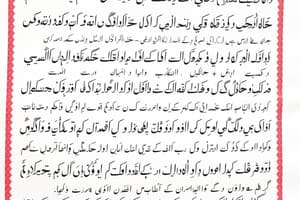Podcast
Questions and Answers
What is the predominant script used to write Urdu?
What is the predominant script used to write Urdu?
- Devanagari script
- Cyrillic script
- Arabic script
- Modified Persian script (correct)
Which of the following sounds are characteristic of Urdu phonology?
Which of the following sounds are characteristic of Urdu phonology?
- Nasal vowels
- Click consonants
- Glottal stops
- Retroflex consonants (correct)
What is the typical sentence structure in Urdu?
What is the typical sentence structure in Urdu?
- Subject-Object-Verb (SOV) (correct)
- Subject-Verb-Object (SVO)
- Verb-Subject-Object (VSO)
- Object-Subject-Verb (OSV)
Which literary form is most closely associated with expressing love and loss in Urdu literature?
Which literary form is most closely associated with expressing love and loss in Urdu literature?
What type of cultural significance does Urdu hold in South Asia?
What type of cultural significance does Urdu hold in South Asia?
Which of the following is NOT a major dialect of Urdu?
Which of the following is NOT a major dialect of Urdu?
What influences the vocabulary of Urdu the most?
What influences the vocabulary of Urdu the most?
What type of resources are available for learning Urdu?
What type of resources are available for learning Urdu?
Flashcards are hidden until you start studying
Study Notes
Overview of Urdu
- Urdu is an Indo-Aryan language primarily spoken in Pakistan and India.
- It is one of the 22 scheduled languages of India and the national language of Pakistan.
- Urdu has a rich literary tradition, with notable poets like Ghalib and Faiz Ahmed Faiz.
Linguistic Features
- Script: Written in a modified form of the Persian script; consists of 38 letters.
- Phonology: Contains sounds not present in many other languages, including retroflex consonants.
- Vocabulary:
- Predominantly derived from Persian and Arabic.
- Influences from Turkish, English, and regional languages in India.
Grammar
- Sentence Structure: Typically follows Subject-Object-Verb (SOV) order.
- Nouns and Pronouns: Gendered nouns; possessive forms indicated by suffixes.
- Verbs: Conjugation based on tense, mood, and aspect; agreement with subjects in person and number.
Dialects
- Major dialects include:
- Dakhni: Spoken in the Deccan region.
- Hindustani: A blend of Hindi and Urdu, often used in urban areas.
- Khariboli: Influential in the development of modern standard Urdu.
Literature and Poetry
- Urdu literature is known for its poetry, particularly Ghazals and Nazms.
- Rich tradition of prose, including novels and essays.
- Important literary genres include:
- Ghazal: A form of lyrical poetry expressing love and loss.
- Masnavi: A narrative poem; often romantic or moralistic in nature.
Cultural Significance
- Urdu serves as a cultural marker for identity in South Asia.
- It plays a vital role in music, particularly in genres like Qawwali and Ghazal singing.
Current Status
- Widely spoken by millions; significant presence in media, education, and politics.
- Faced challenges due to language politics in India and Pakistan but continues to thrive through cultural expressions.
Learning Resources
- Language courses, online platforms, and mobile applications available for learners.
- Books and anthologies of Urdu poetry and prose for literary exploration.
Overview of Urdu
- An Indo-Aryan language, Urdu is predominantly spoken in Pakistan and India.
- Designated as one of India’s 22 scheduled languages and serves as Pakistan’s national language.
- Celebrated literary heritage highlighted by notable poets like Ghalib and Faiz Ahmed Faiz.
Linguistic Features
- Script: Utilizes a modified Persian script consisting of 38 letters.
- Phonology: Features unique sounds, including retroflex consonants, uncommon in many other languages.
- Vocabulary:
- Primarily derives from Persian and Arabic, with additional influences from Turkish, English, and various regional languages.
Grammar
- Sentence Structure: Follows a Subject-Object-Verb (SOV) format.
- Nouns and Pronouns: Contains gendered nouns, with possessive forms indicated by specific suffixes.
- Verbs: Conjugation varies by tense, mood, and aspect, ensuring agreement with subjects based on person and number.
Dialects
- Dakhni: Predominantly spoken in the Deccan region.
- Hindustani: A fusion of Hindi and Urdu, frequently utilized in urban settings.
- Khariboli: Significant in shaping modern standard Urdu’s development.
Literature and Poetry
- Urdu literature is renowned for its poetry, particularly in forms like Ghazals and Nazms.
- Prose tradition is rich, encompassing novels and essays.
- Ghazal: A lyrical poetry form that delves into themes of love and loss.
- Masnavi: A narrative style of poetry often exploring romantic or moral themes.
Cultural Significance
- Acts as a key cultural identifier in South Asia, symbolizing heritage and community.
- Integral to musical traditions, especially in Qawwali and Ghazal performances.
Current Status
- Spoken by millions; maintains a strong presence in media, education, and politics.
- Faces challenges stemming from language politics in both India and Pakistan, yet continues to flourish through cultural expressions.
Learning Resources
- Availability of language courses, online platforms, and mobile applications for learners.
- Access to books and anthologies featuring Urdu poetry and prose aimed at literary enthusiasts.
Studying That Suits You
Use AI to generate personalized quizzes and flashcards to suit your learning preferences.




